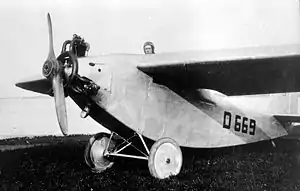Bristol Lucifer
The Bristol Lucifer was a British three-cylinder, air-cooled, radial engine for aircraft. Built in the UK in the 1920s by the Bristol Aeroplane Company, it produced 100 horsepower (75 kW).
| Lucifer | |
|---|---|
 | |
| Bristol Lucifer, installed in LFG V 44 D-669 | |
| Type | Piston aero engine |
| Manufacturer | Bristol Aeroplane Company |
| First run | 1919 |
| Major applications | Avro 504 |
The Lucifer was originally a Cosmos Engineering engine, Cosmos being taken over by Bristol in 1920.
Applications
- Albatros L 69
- Avro 504
- Boulton Paul P.10
- Bristol M.1D
- Bristol Primary Trainer
- Bryant 1927 monoplane (Dole Race entrant, christened Angel of Los Angeles)
- Handley Page Hamlet
- LFG V 44
- NVI F.K.29
- Parnall Peto
- Tupolev ANT-2
- Udet U 8
Specifications (Lucifer 1)

Bristol Lucifer, view of sectioned cylinder.
Data from Lumsden[1]
General characteristics
- Type: 3-cylinder air-cooled single-row radial engine
- Bore: 5.75 in (146 mm)
- Stroke: 6.25 in (159 mm)
- Displacement: 487 in³ (8.0 L)
- Diameter: 48 in (1,219 mm)
- Dry weight: 324 lb (147 kg)
Components
- Valvetrain: Four valves per cylinder, poppet valve
- Fuel type: Petrol
- Cooling system: Air-cooled
Performance
- Power output: 100 hp (75 kW)
- Compression ratio: 4.8:1
- Power-to-weight ratio: 0.3 hp/lb (0.5 kW/kg)
References
Wikimedia Commons has media related to Bristol Lucifer.
Notes
- Lumsden 2003, p. 93.
Bibliography
- Lumsden, Alec. British Piston Engines and their Aircraft. Marlborough, Wiltshire: Airlife Publishing, 2003. ISBN 1-85310-294-6.
This article is issued from Wikipedia. The text is licensed under Creative Commons - Attribution - Sharealike. Additional terms may apply for the media files.